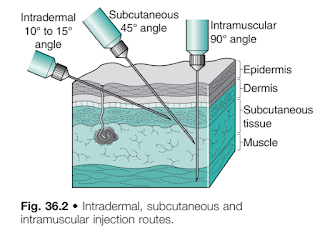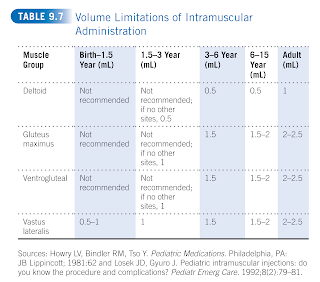Parenteral Route
Introduction
A drug administered parenterally is one injected via a hollow needle into the body at various sites and to various depths.
- Subcutaneous or hypodermic (under the skin)
- Intramuscular (muscle)
- Intravenous (vein)
- Intradermal (skin)
- Intraspinal (spinal column)
- Intrathecal (spinal fluid)
- Intracardiac (heart)
- Intraarticular (joint)
- Intrasynovial (joint fluid area)
- Intraocular (eye)
NOTE: All parenteral products must be sterile.
Indications
The parenteral route is preferred when
- Rapid absorption is essential, as in emergency situations
- Intravenous injection delivers the drug directly into the circulatory system, where it is then rapidly distributed around the body.
- Conversely, if a drug is administered by intramuscular injection, the release of the medicine from the injection site into the circulation can be delayed and prolonged.
- When patients are unconscious or unable to accept oral medication
- To provide a highly localized effect
- e.g. Intra-articular steroids
- Drugs are destroyed, inactivated or poorly absorbed following oral administration.
- e.g. Insulin injections, aminoglycosides gentamicin,
Disadvantages
- Primarily associated with pain and inconvenience.
Intravenous Administration
IV administration delivers the medication into the blood stream through 2 methods.
- Direct Push (IV Bolus)
- Lasting a few seconds to minutes, with the intent of producing a high drug concentration rapidly. However, most injections should normally be administered over 2 to 5 minutes.
- It is impractical if a drug needs to be given slowly or in a large volume.
- Intermittent or Continuous Infusion
- Involves administration over a longer time period often using larger volumes.
- Continuous infusion over 24 hours is indicated for drugs with short half-life (e.g. glyceryl trinitrate) and/or when a constant therapeutic drug level is required (e.g. insulin).
Incompatibility issues can arise during parenteral medication administration.
- Chemical incompatibility
- Causes drug degradation due to a hydrolysis, oxidation or decomposition reaction.
- Physical incompatibilities occur between a drug and one of the following:
- The container (e.g. polyvinyl chloride containers - leaching of diethylhexyl phthalate (DEHP) from the container or drug absorption into the PVC containers)
- The diluent (solution) (e.g. dextrose or saline)
- Another drug - e.g. when mixing drugs in the same container or Y-site administration.
Subcutaneous Routes
The subcutaneous route results in slow, steady drug absorption.
- Examples: Insulin, enoxaparin.
Intramuscular Routes
IM injections require a longer needle to access the muscle tissue, hence is more uncomfortable for the patient.
- The volume of medication is determined by the age of the patient and the muscle selected, but typically not more than 3 ml.



Comments
Post a Comment